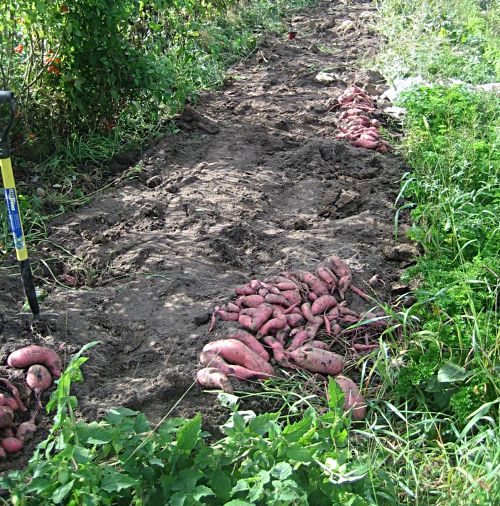 There is one way of planting sweet potato (camote) that has been tried that can make it yield 20% more than the ordinary way of planting. In the manner tried, the stems to be planted are taken from healthy plants, two to three months old. The cut stems to be planted are watered first, then covered with a plastic sheet for two days When ready for planting, the stems will have developed small roots which will hasten the growth of the new plant. It is advised by a Puerto Rican researcher not to remove the leaves before planting, as this will reduce the roots that will eventually become crops.
There is one way of planting sweet potato (camote) that has been tried that can make it yield 20% more than the ordinary way of planting. In the manner tried, the stems to be planted are taken from healthy plants, two to three months old. The cut stems to be planted are watered first, then covered with a plastic sheet for two days When ready for planting, the stems will have developed small roots which will hasten the growth of the new plant. It is advised by a Puerto Rican researcher not to remove the leaves before planting, as this will reduce the roots that will eventually become crops.
Harvesting
Sweet potatoes can be harvested about 3 1/2 – 4 months after planting. If the harvesting is made too early or too late, only a few crops are harvested and the quality is not good. The over matured ones are fibrous and rot easily. Do not harvest sweet potato after a rain or when the ground is wet because the fruit contains much water then, which will make it rot easily. Besides, it is harder to gather and clean the crops when the soil is muddy it is easy to harvest when the soil is dry.
Methods in Growing Sweet Potatoes

Procedure in harvesting:
- Cut the vine first, roll it over to one side and plow the beds to bring out the crops.
- If the harvesting is done manually, do not use pointed metal instruments but only wooden tools with a pointed end so as not to hurt the crop.
- Carefully cut the vine in separating the crop so as not to hurt the crop.
- Cut the vine closest to the crop.
- Do not pile up the crops so as not bruise them.
- Do not leave the newly harvested crops exposed in the sun. This will make them dry up and shrivel.
- Put the crops under the shade.
Storing Procedure
Sweet potatoes will last 2-3 months when properly harvested.
- Use a right sized basket to contain the harvest of sweet potato – not overflowing so as not to bruise them. It is in bruises and hurts that rotting starts.
- Because of this, do not use sacks for storing.
- The storage place must be nearest to your house or the farm or wherever the crops will be transported with facility.
- Use bamboo, cogon or coconut leaves for roofing and sawali for walls in storage places.
Source: www.elgu2.ncc.gov.ph; Photos: rawinspirations.wordpress.com and csa.amandadevries.com